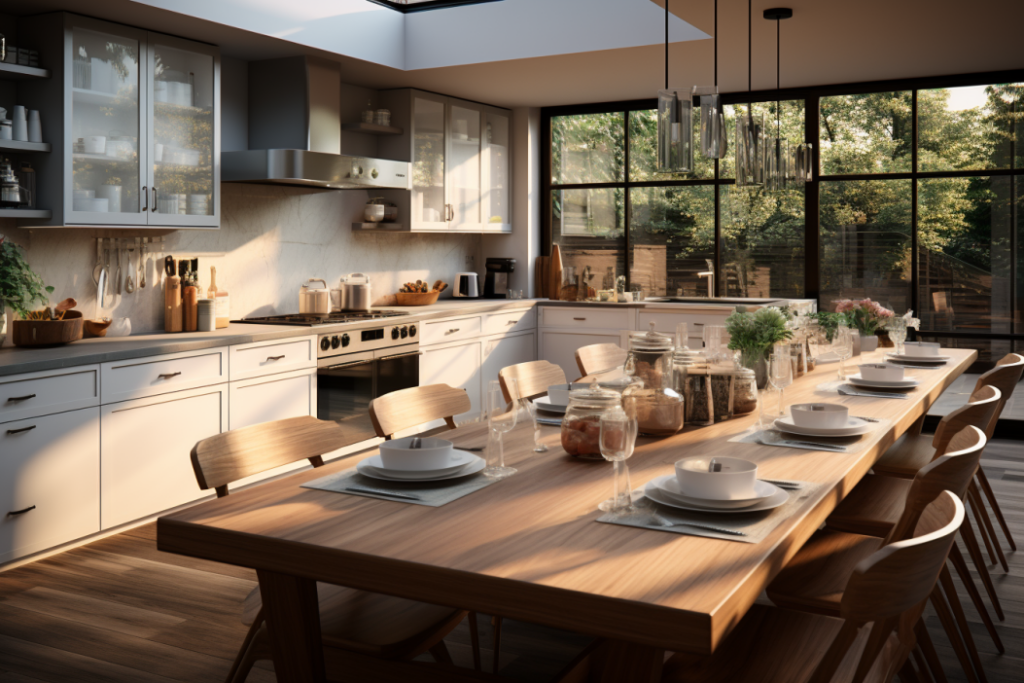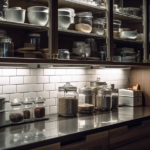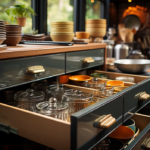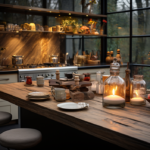Table of Contents
Mastering the Art of Kitchen Organization: Secrets from Professional Chefs
Hey there, kitchen enthusiasts!
Do you ever watch cooking shows and wonder how the professional chefs keep their kitchens so immaculately organized? I mean, they always seem to have precisely what they need in the blink of an eye, right? How come their space never seems to descend into chaotic messes like ours do?
Well, I’ve got some delightful news for you all – it’s totally possible to organize your own kitchen like a pro chef! And it’s not as hard as you might think. So let’s stop envying these kitchen maestros and start learning from them.
Stick around as we dive into the secret sauce of kitchen management. You’ll get a spice-full of tips to transform your kitchen into one that even Gordon Ramsay wouldn’t yell at! Whether you’re a passionate home cook, or someone who mostly uses the kitchen to microwave leftovers, mastering professional chef organization will level up your culinary game.
So, are you ready to get your kitchen game teeming with professional chef vibes? Let’s get rolling!
Understanding the Professional Chef’s Mindset
The first step to organizing your kitchen like a professional chef is getting into their mindset. Chefs don’t just throw their tools and ingredients randomly into cupboards. There’s a detailed method to the madness that makes their kitchen operations quick and efficient.
See, professional chefs view their kitchens as an extension of themselves. They recognize that a well-organized kitchen equals a smooth cooking process. So what’s the first rule of Chef Club, you ask? Everything in its place, or as they fancily say in the culinary world, “Mise en Place.”
Mise en Place
You’ve probably heard this term thrown around on cooking shows. Literally translated as “put in place,” it refers to the practice of prepping and organizing all the necessary ingredients and tools before starting to cook. The aim is to have everything you need at your fingertips when you need it.
This means no more rummaging through drawers for that elusive can opener or running to the pantry mid-cook because you forgot the paprika. Talk about a time-saver, right?
So, take a page out of the professional chefs’ cookbook. Start by organizing your tools and equipment logically. Group them by function or frequency of use. Got a favorite spatula? Don’t hide it at the back of a drawer. It’s a rockstar; treat it like one!
As for ingredients, keep the ones you use most often within easy reach. This could be oils, sauces, or spices, depending on your cooking style.
Embrace the Mise en Place approach and see how it supercharges your culinary exploits. Because, spoiler alert: organized kitchens do cook better.
So, let’s get down to chef business. Remember, great cooking goes beyond following a recipe – it’s all about playing the game with a winning strategy! And, that strategy starts with a well-organized kitchen.
Figuring Out Your Kitchen’s Flow and Function
Ever watched a professional chef effortlessly glide from refrigerator to stove, cutting board to oven, in a sort of culinary ballet? That’s because they know exactly where everything is, and they position their tools and ingredients to compliment the kitchen’s flow. It’s all about functionality, baby!
The Mighty Work Triangle
No, this isn’t a mystical shape from a Dan Brown novel. The work triangle refers to creating a direct path between the three essential kitchen workstations: your refrigerator, stove and sink. Maximizing efficiency in these areas can make your kitchen workflow razor sharp.
Think about it. Most of your kitchen action happens at these spots. Prep work at the sink, cooking at the stove, and grabbing ingredients from the fridge. Keeping these areas easily accessible can seriously amp up your kitchen game.
Tailored to Your Needs
Every cook is unique. Your Grandma’s secret recipe is different from mine (though equally delectable, I’m sure!). And so should be the way we organize our kitchens. Tailor your kitchen set-up to your cooking style.
Love to bake? Designate a particular zone for those fancy pastry tools. More of a BBQ-enthusiast? Then make the honors list by placing grill tools in the limelight. Remember, your kitchen should resonate with your culinary personality.
The Sometimes, Seldom, Never Rule
This one’s a game-changer. Think about your kitchen items in terms of utilization. Group them as ‘Sometimes’ (used once a week or so), ‘Seldom’ (used less often), and ‘Never’ (you know, the ones that gather dust). Plan your storage accordingly. This strategy aids in maximizing your kitchen space and maintaining a tidier kitchen.
Remember, professional chefs aren’t just culinary maestros; they’re also masters of space management. It’s time we let a little of their wisdom spice up our kitchen’s flow and function. Bon appétit!
Mastering the Art of Zoning: A Chef’s Secret Hack
Taking a leaf out of a professional chef’s book again, we bring you their secret hack: The Art of Zoning. Yup, zoning in the kitchen is a real thing and it can do wonders for your culinary space!
What’s Zoning Anyway?
Just like cities have zones for commercial, residential, or leisure activities, consider creating different “zones” within your kitchen based on specific tasks. This, my friends, is kitchen zoning. The idea is to group items by their function and position them accordingly.
Setting Up Your Zones
Think about how you move when you cook. You chop veggies, sizzle them on the stove, set them aside on a plate, and so on. Now, imagine having all your chopping tools and veggies near your cutting board, cooking tools near the stove. That’s right, you’ve just created a ‘Prep Zone’ and a ‘Cooking Zone.
You can continue this with other kitchen operations as well, like a ‘Baking Zone’, ‘Cleaning Zone’, or a ‘Storage Zone’. The objective is to minimize unnecessary movement, making your kitchen work smoother and simpler. Efficiency 101, people!
Customizing Your Zones
Remember, no two hobby cooks are alike, and neither should be their kitchens. A chef might need a ‘Saute Zone’, but you might need a ‘Pasta Zone’. Shape your zones to fit your style.
Think about your workflow, the dishes you love to make, and the tools you always use. This will give you clues as to what zones your kitchen needs.
Remember the Golden Rule
Keep the most frequently used items in easy reach. Those poor, neglected ‘Once in a Blue Moon’ items can be stored up high or in harder-to-reach areas.
Applying the art of zoning can turn your kitchen into a culinary canvas. Get set to see a radical improvement in your cooking experience! Ready to zone out with me? Let’s do it!
The Essentials: Getting Your Equipment and Ingredients in Order
Finally, let’s dish out about your kitchen’s backbone – the equipment and ingredients. Getting these babies in order is like tuning an instrument before the orchestra begins. It’s an absolute must!
Maximizing Equipment Efficiency
Let’s talk pots, pans, and gadgets. Don’t just stash them away. No, no, no! Think about where you’re locating them. Group your tools by function and keep them near the appropriate zone. Baking trays near the oven, cutting knives near the chopping board—you get the drift.
Streamlining your tools storage not only saves you time but also prevents that frantic search mid-cooking when you suddenly remember you need a steaming basket. Funnily enough, it always magically appears once the pasta has already morphed into a gooey, overcooked mess, doesn’t it?
Ingredient At-a-Glance
A chef’s ingredient pantry is a treasure trove. And it’s always in rhyming order, from amaranth grain to za’atar spices!
Adopt the ‘At-a-Glance’ philosophy for your ingredients, especially spices. Arrange them alphabetically, by cuisine, or by frequency of use – whatever works for you. Try to arrange them so that you can see them all at a glance, no spice left behind!
Remember, visibility leads to usability. If you spot it, you’ll use it. So, bring all those hidden ingredients into the forefront and start exploring their culinary potential.
Shelf Life = Shelf Location
Your dry goods, cans, and jars should be stored based on their expiry dates. Don’t let any ingredient feel neglected at the back of the shelf, reaching its expiry date alone and unused.
Create a ‘First In, First Out’ system – New purchases go at the back, older ones at the front. This way, you’ll easily keep track of what needs to be used up hereby reducing food waste!
Alright, folks, armed with these chef-inspired strategies, it’s time to make your kitchen dance to your tunes. Trust me; you’ll soon wish you’d cracked these secrets sooner! So, who’s ready for a kitchen makeover?
Dealing with Dishes: Easy Clean-up Strategies from Pros
Alright, let’s face it. We all love the art of cooking, but when it comes to dealing with the aftermath – the towering pile of dirty dishes – our enthusiasm somehow seems to fizzle out. Here’s the good news: efficient clean-up is not beyond our reach! It’s time to lift some secrets from the pros.
The ‘Clean As You Go’ Rule
Ever noticed how chefs manage to keep their workspace clean amidst all that fiery cooking action? The magic mantra here is ‘Clean As You Go’ or “CAYGO”! It’s their secret weapon against growing clutter as they cook.
Instead of letting dirty dishes pile up, they clean tools and prepware as they finish using them. This not only keeps the space tidy but also saves a huge cleaning task at the end. So why not bring a little “CAYGO” magic into our own kitchens?
Everything in its Place
Post-cooking clean-up is also about keeping things in their proper place. Designate specific spots for your dishes, glassware, and cutlery. This not only helps you find them effortlessly next time but also ensures a rapid clean-up. Remember, an organized kitchen equals a quicker tidy-up process.
Transferring Leftovers Right
Transferring leftovers directly into storage containers can also save you the extra cleaning of serving dishes. Invest in quality, microwave-safe containers. Professional chefs ensure nothing goes to waste, and so should we!
Last But Not the Least
Consider a cleaning zone. Yes, your kitchen needs it! It could be a drawer or a cupboard where you store your cleaning supplies. This way, everything you need for a quick clean-up is at your fingertips, saving you from that mad scavenger hunt for soap or scrubbers.
Remember, professionals believe that food prepared in a clean environment tastes better. So clean-up ain’t dull – it’s part of the culinary journey. Here’s to dishwashing becoming less of a chore and more of a joy. Happy cleaning!
Streamlining Your Storage: Where to Put What and Why
Alright kitchen kings and queens, let’s take the plunge into something every cook, pro or novice, needs to ponder over – kitchen storage. Believe it or not, how and where you store your kitchen goodies can make a massive difference to the functionality of your space. Let’s explore this further!
Whatcha Cookin’, Good Lookin’?
Here’s a juicy nugget from the chef’s handbook: store based on what you cook. Pasta lovers might want their pasta tools front and centre, while bakers might need easy access to the stand mixer and cookie trays. The bottom line is, keep your frequently used tools and ingredients within easy reach.
Seeing Double?
Pro chefs keep a keen eye on reducing duplicates. Yes, 10 metal spoons might seem handy, but do you really need them all at once? Review your essentials, be brutal and declutter unnecessary duplicates.
Let’s Vent a Bit
Alrighty, never underestimate the value of good ventilation. Store your perishables where there’s ample air circulation. This is why the fridge has different compartments for different foods, take advantage of it!
Divide and Conquer
Consider using dividers or storage boxes to break down large drawers or cabinets. This can help keep things neat, visual, and grouped according to function or type.
Unlock the Vertical Potential
Think up! Can you install a ceiling mounted pot rack, or a magnetic spice rack on the inside of a cabinet door? Going vertical can free up valuable counter and shelf space.
By streamlining your storage, you’ll be following in the footsteps of many a culinary whiz, making each cooking venture a smoother, stress-free experience. So, let’s turn those cluttered cabinets into a haven of organised bliss. Because let’s face it, we kitchen enthusiasts deserve nothing less!
Spices and Dry Goods: The Chef’s Method of Organisation
Spices and dry goods can either be a cook’s confidantes or clutter causers! Today let’s master the art of organizing them the professional chef way. Buckle up, spice lovers!
Spice Up Your Life (and Drawers!)
There’s a reason chefs can grab the right spice with their eyes closed. Their mantra? Visual and easy access. Consider a rack that displays spices in tiers so you can see them all at once – no more culinary hide and seek!
Try arranging them alphabetically, by cuisine, or by usage frequency. The goal? When you need that smoked paprika, you should be able to lay your hands on it instantly!
Dry Good Dividends
Dry goods like pasta, grains and legumes are kitchen superheroes that deserve their spots in the limelight! How? Clear containers.
Switch to glass or clear plastic containers that let you identify your dry goods easily. Bonus points for adding labels and expiry dates—it’s super helpful, and it looks pretty darn impressive!
The Golden Rule – FIFO
“First In, First Out” – this grocery store concept lands in our kitchens too. It’s simple — use your oldest dry goods first, keep shuffling your stocks to make sure none of it is past the expiration date.
Going Nuts over (and with) Baking Goods
For those with a sweet tooth, organising baking goods can be a conundrum. No more! Designate a baking drawer/box for your cocoa, baking soda, chocolate chips, and such stuff. No more zipping around the kitchen mid-baking!
The secret spice to a chef’s well-organized kitchen is streamlining the chaos of spices and dry goods. And with these tips, that chaotic drawer spilling over with half-empty spice packets is a thing of the past, as we welcome a fresh wave of kitchen zen into our lives! Grab your alphabetizer, folks; it’s time to shake things up — Spice style!
Cold Storage Organization: Making Your Fridge Work for You
Moving on from pantries and cabinets, let’s stroll over to the coolest spot in your kitchen – the fridge! Contrary to popular belief, there’s a science to stocking your fridge. Let’s deep-dive into how to mimic a pro chef’s refrigerator organization!
Zone is the Tone
Just like your kitchen, your refrigerator needs zoning too. Different compartments have different temperatures, and organizing items accordingly ensures they retain optimal freshness. Try to group items based on type – dairy, meats, veggies, sauces and leftovers.
Door Duty
The door is the warmest zone of your fridge. Utilize it for items that are less susceptible to spoiling. Think condiments, sauces, and drinks.
Drawer Decisions
Use your crisper drawers to their full potential. Most fridges allow for humidity control for each drawer. Lower humidity for fruits, and higher for veggies, this will help keep them fresh.
Top or Bottom?
A thumb rule: store cooked food or ready-to-eat items on top, raw foods at the bottom. It’s a safe way to prevent any cross-contamination.
Room for Breathing
Ever come across recipes suggesting resting the food? Your fridge contents require chilling out too! Space them out. It helps maintain the temperature consistently throughout, and also makes spotting items simpler.
Clear is the Way
Go for clear containers as far as possible. They let you quickly identify leftovers and use them before they go bad.
Now, who’d have thought organising a refrigerator could be this scientific, right? The next time you stock up groceries or finish cooking a meal, remember these tips. That way, you’ll avoid those ‘science experiments’ in the back of the fridge, save money, and always have something good to eat on hand. Whoever said you can’t teach an old fridge new tricks?!
Putting It All Together: A Step-by-Step Plan to Chef-Worthy Kitchen Organization
Alright, now that we’ve sliced and diced every part of the kitchen organization journey, let’s blend it all into a step-by-step action plan! Let’s roll up our sleeves and craft a kitchen that is worthy of a Michelin star chef.
Step 1: Mindset & Blueprint
First things first, channelize the professional chef’s mindset. Remember, organization equals efficiency. Sketch a rough blueprint of your kitchen. Identify key areas like your stove, fridge, sink and quantify other available space.
Step 2: Figure Out Your Flow
Next, optimize your kitchen flow. Organise your refrigerator, sink, and stove in a direct path, forming an efficient ‘Work Triangle’. Customize this to your cooking style and habits.
Step 3: Zone Master
Create functional zones in your kitchen, aligning tools and ingredients with their respective zones. You could have a ‘Prep Zone’, ‘Cooking Zone’, ‘Baking Zone’, or a ‘Cleanup Zone’. This notch up in your organization game will pay off massively.
Step 4: Equipment and Ingredient Order
Time to declutter! Group equipment by function, shelve ingredients alphabetically or by usage. Utilize the ‘First In, First Out’ rule for stock rotation.
Step 5: Streamline Storage
Go for clear containers for dry goods, designate storage spots for dishes and cutlery, and segregate equipment based on frequency of use. Remember to use vertical spaces too!
Step 6: Spruce Up Your Spices
Finally, arrange your spices and dry goods for maximum visibility. A drawer or a rack that lets you see all your spices at a quick glance works best.
Implementing this step-by-step journey might take a few days or even a weekend, depending on your kitchen’s size. But trust me, the result is immensely satisfying and beneficial, from reduced cook time to stress-free meal preparation. So what are you waiting for? Aprons on, let’s dive in!
Conclusion
Well, that’s the full tour, folks! We’ve covered every nook and cranny of the kitchen and spilled all the behind-the-scenes secrets that make a professional chef’s kitchen tick with flawless efficiency.
Remember, our kitchen is more than just a functional space – it’s where magic happens, where flavors come to life, and memories get whipped up over steamy stovetops. So, it totally deserves that dash of extra attention and organization.
Even though the process might seem a tad bit overwhelming at first, trust the journey. Sure, it might require some rearranging and decluttering, but believe me, there’s nothing more rewarding than seeing your kitchen transform into a space of culinary creativity and efficiency.
And who knows? With a kitchen organized like a pro chef’s, you might just find yourself elevating those daily meals to master chef status! So, aprons on, senses alert, and embrace the joy of cooking in a kitchen that’s nothing short of a professional culinary playground!
Are you ready to master the chef’s secret recipe for an organized kitchen? Let’s rise to the challenge, one spice rack at a time! Happy organizing, dear kitchen enthusiasts.







